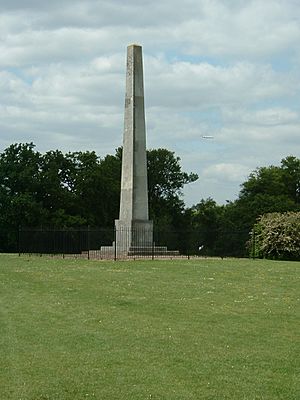Mayfield Park, Southampton facts for kids
Mayfield Park is a fun outdoor area in Southampton, England. It stretches across two parts of the city, Woolston and Weston. A small stream flows through the park, marking the border between these two areas.
This park is looked after by Southampton City Council. Long ago, it was part of a big estate called Weston Grove, owned by the Chamberlayne family. Most of that estate was later used to build the modern Weston neighborhood. Mayfield Park survived because it became its own separate property, the Mayfield Estate, in the 1800s.
Contents
History of Mayfield Park
Early History: A Mill by the Stream
A stream runs through Mayfield Park, starting from a nearby place called Miller's Pond. This stream flows through a valley in the park, carrying water from the higher lands of the Hampshire Basin into Southampton Water. In 1762, a man named Walter Taylor built a special mill here. This mill used the power of the water to cut and shape wood. Millers Pond was created to hold enough water for the mill to work.
Later, in the 1800s, the mill building was changed into a private house. Sadly, this house was badly damaged during World War II and was left empty. Today, archaeologists from Southampton City Council have explored the old mill site to learn more about its past.
19th Century: Important People and a Memorial
Mayfield Park was once part of a much larger area called the Weston Grove Estate. This estate belonged to William Chamberlayne. In 1810, Mr. Chamberlayne put up a tall stone monument to remember Charles James Fox. Fox was a famous politician from the Whig group. The monument is an obelisk (a tall, thin, four-sided pillar) and stands on the highest point of the estate, where a windmill used to be. William Chamberlayne later became a MP for Southampton from 1818 to 1830.
In 1854, another Chamberlayne family member, Thomas Chamberlayne, sold part of the estate. It was bought by Colonel Robert Wright. Colonel Wright built a house called Mayfield House there, creating the Mayfield Estate. He later dedicated the obelisk to two of his favorite horses, who are buried in the park.
From 1889 to 1913, Mayfield House and the estate were owned by Granville Augustus William Waldegrave, who was the 3rd Lord Radstock. He had worked as a missionary in Russia before this. During his time at Mayfield Estate, Lord Radstock added a special message to the obelisk. It says: "The earth is the Lord's and the fullness thereof – Psalms 24.1".
20th Century: War, New Homes, and Changes
When the 3rd Lord Radstock passed away in 1913, his title and the Mayfield estate went to his son, Granville George Waldegrave, 4th Baron Radstock.
During World War I, Mayfield House was used to help wounded soldiers. It became an extra building for the Royal Victoria Military Hospital in Netley.
After World War I, many large estates in England faced difficulties. Many young men who would have inherited or worked on these estates were lost in the war.
When the 4th Lord Radstock died in 1937, his 70-year-old brother, Montague Waldegrave, became the 5th Lord Radstock. The family could no longer afford to keep up the Mayfield estate. So, it was sold to Southampton City Council. The 4th Baron's will included a rule that the land must always be kept as an open space for everyone to enjoy.
During World War II, people from Southampton who had lost their homes were temporarily housed in Mayfield House. This large building had 40 rooms, including 23 bedrooms.
In 1944, the area around Mayfield Park was used to gather soldiers and equipment. This was part of the preparations for D-Day, a very important event in World War II.
After World War II, Southampton City Council used part of the old Weston Grove Estate to build new homes. This became the Weston Housing Estate. Weston Park Boys and Girls schools were built there in 1957.
The title of Lord Radstock ended when the 5th Lord Radstock died in 1953. Mayfield House itself was taken down a few years later, in 1956.
Mayfield Park's Legacy Today
You can still find many reminders of the park's history in the local area. Roads like Chamberlayne Road, Radstock Road, Wrights Hill, and Obelisk Road are named after the people and features connected to Mayfield Park. There's even a public house called The Obelisk nearby.
An extra building for Woolston School was also named Mayfield House. It was not the original house from the estate, but it shared the name.
The Chamberlayne Leisure Centre opened in April 2000, providing a modern facility for the community.
Weston Park Boys school has changed its name over time, first to the Grove Park Business and Enterprise College and more recently to Oasis Academy Mayfield.
Weston Park Girls school also changed its name, first to Chamberlayne Park School and then to Chamberlayne College for the Arts.


